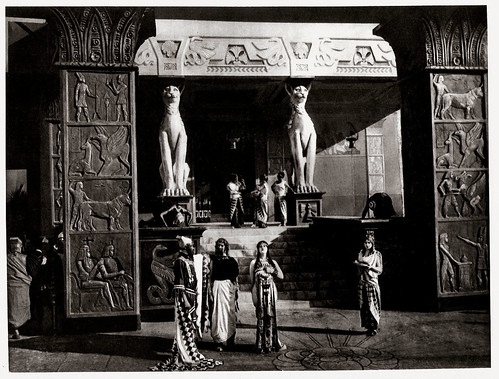
Publicity still of the Italian silent film classic Cabiria (Giovanni Pastrone, 1914), with Alex Bernard, Edoardo Davesnes, Italia Almirante-Manzini and Lydia Quaranta.

Italian postcard by RPH, no. 3546. Photo: Varischi Artico.& Co., Milano. Mailed 18 May 1906. Ruggero Ruggeri as Aligi in the stage play 'La figlia di Jorio' (1904).

Vintage Italian postcard. Publicity for the staging of the play 'La Nave' by Gabriele D'Annunzio at the Teatro Comunale in Bologna in May 1908.

French postcard by RA, no. 109. Photo: A. Bert. Ida Rubinstein in the French stage production Le Martyr de St. Sebastien (1911).

Italian postcard by IPA CT, no. 3876. Photo: Film della Soc. Ambrosio, Torino. V. Uff. Rev. St., Terni. Umberto Mozzato as Lucio Settala and Helena Makowska as Gioconda Dianti in La Gioconda (Eleuterio Rodolfi, 1916). Caption: Lucio Settala is madly in love with his model Gioconda Dianti.
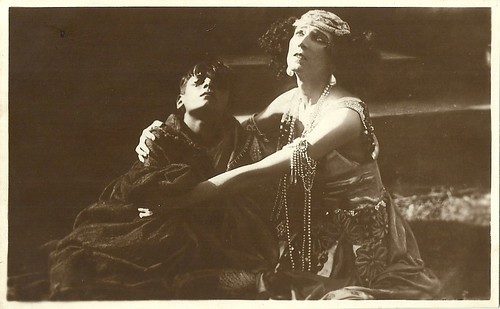
Italian postcard. Photo: Unione Cinematografica Italiana / Ambrosio-Zanotta. Ida Rubinstein in the Italian silent film La nave (Gabriellino D'Annunzio, Mario Roncoroni, 1921), based on the homonymous play by Gabriele D'Annunzio.
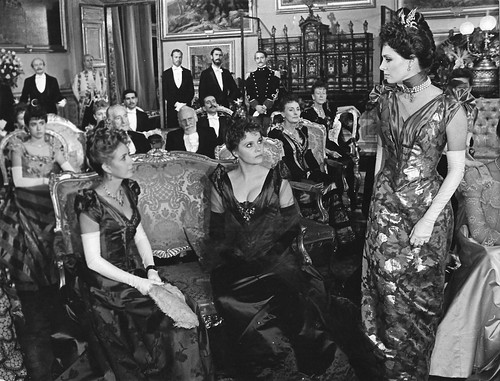
Italian press photo. Photo: Mario Tursi. Marie Dubois, Laura Antonelli and Jennifer O'Neill in L'innocente/The Innocent (Luchino Visconti, 1976). Setting: Palazzo Colonna, Rome. Collection: Ivo Blom.
The cult of beauty
Gabriele D'Annunzio was born in 1863 in Pescara into a wealthy family of landowners. His father's name was Francesco Rapagnetta. At the age of 13, Francesco was adopted by his uncle Antonio D'Annunzio, after which he assumed the surname D'Annunzio. Gabriele attended school at the lycem Cicognini at Prato in Tuscany. In 1879. at the age of 16, he published his first book of poetry, called 'Primo Vere'. He was influenced by the poetry book 'Odi barbare' by Giosuè Carducci, but also by the poet Lorenzo Stecchetti, whose work 'Postuma' was then in vogue. In order to attract more attention to his book of poetry, he sent a fictitious story to a newspaper, stating that he had died in a fall from a horse.
D'Annunzio was a brilliant student, reading everything his teachers recommended and even more. He devoured the works of Plutarch, Virgil, Catullus, Italian Renaissance poets, Niccolo Tommaséo, Manzoni, Stoppani, De Gubernatis, Byron, Goethe, Milton, and Darwin, among others. He remained in the capital until 1891. He stayed there in the palazzo Roccagiovine, among other places. D'Annunzio tried to distinguish himself from the masses by living like a dandy. As for his clothes, he was very meticulous and fastidious. For instance, he refused to wear clothes made in Italy. At the time, French or British fashion was held in higher esteem than Italian. In 1882, he published a collection of poems entitled 'Elegie romane', which was a response to Goethe's 'Roman Elegies', a work that recounted the German author's journey to Italy (1786-1788).
In 1883 he caused a scandal. He kidnapped Countess Maria Hardouin di Gallese and finally married her when she was already pregnant with their first child. She gave him three sons. His first novel, 'Il piacere' (The Child of Pleasure, 1889) received good reviews. The main character Andrea Spirelli, a young aristocrat, is based on the author himself. One of the most striking consequences of d'Annunzio's appearance in the literary world was the creation of a d'Annunzian audience of his own, formed not so much by the content of his work as by the star power assumed by the author. His scandalous behaviour, the cult of beauty, and his disregard for bourgeois values created an aura of fascination.
Then followed two other novels, 'L'Innocente' (The Intruder, 1891) and 'Giovanni Episcopo' (1892). These three novels made a strong impression on the public. 'L'Innocente' was praised by foreign literary critics and would later be filmed by Luchino Visconti. D'Annunzio's next work, 'Il trionfo della morte' (The Triumph of Death, 1894), was followed soon by 'Le vergini delle rocce' (The Maidens of the Rocks, 1896) and 'Il fuoco' (The Flame of Life, 1900).
D'Annunzio became a member of the Italian parliament for the conservatives in 1897. He was an extreme nationalist. In 1901, D'Annunzio and Ettore Ferrari, Grand Master of the Masonic lodge the Great East of Italy, founded the Università Popolare di Milano (People's University of Milan). He had an affair with the famous actress Eleonora Duse, which lasted from 1897 to 1902, and then had a flashback relationship with the eccentric Luisa Casati until a few years before his death.
A later phase of D'Annunzio's work is his dramatic production, represented by 'Il sogno di un mattino di primavera' (1897), a lyrical fantasia in one act, and his 'Città Morta' (The Dead City, 1898), written for Sarah Bernhardt. In 1898 he wrote his 'Sogno di un pomeriggio d'autunno' and 'La Gioconda'; in the succeeding year 'La gloria, an attempt at an contemporary political tragedy which met with no success, probably because of the audacity of the personal and political allusions in some of its scenes; and then 'Francesca da Rimini' (1901), based on an episode from Dante Alighieri's 'Inferno'.
D'Annunzio's profligate lifestyle with rash purchases saddled him with large debts. To escape his Italian creditors, he left for France in 1910. In Paris, he collaborated with Claude Debussy and Léon Bakst on 'Le Martyre de saint Sébastien' (1911), written for Ida Rubinstein and choreographed by Michel Fokine. The work drew the wrath of the Archbishop of Paris, Léon Adolphe Amette, who threatened excommunication for any Catholic attending the performance. Back in Italy, he contributed to the screenplay of the feature film Cabiria (Giovanni Pastrone, 1914). He wrote all of the intertitles, named the characters and the film itself. The film is set in ancient Sicily, Carthage, and Cirta during the period of the Second Punic War (218–202 BC). It follows a melodramatic main plot about an abducted little girl, Cabiria, and features an eruption of Mount Etna, heinous religious rituals in Carthage, the alpine trek of Hannibal, Archimedes' defeat of the Roman fleet at the Siege of Syracuse, and Scipio maneuvering in North Africa. Apart from being a classic on its own terms, the film is also notable for being the first film in which the long-running film character Maciste (Bartolomeo Pagano) makes his debut.

French postcard by A.N., Paris, no. 529. Gabriele D'Annunzio.

Italian postcard, no. 127. Photo: Sciutto, Genova. Eleonora Duse in the play 'La città morta' (The Dead City) by Gabriele D'Annunzio. The photo was made for the performance of Duse in Genoa, Teatro Paganini, in April 1901. The blind Anna holds Bianca Maria onto her lap. She understands that the girl is in love with her own husband Alessandro.

Italian postcard by Alterocca, Terni, no. 4286. A stage production by Compagnia drammatica di E. Berti of 'Francesca da Rimini' (1903), a play by Gabriele D'Annunzio, based on a tale from 'Dante's Inferno' (Paolo & Francesca). The play was first performed in 1901 with Eleonora Duse in the lead. This card refers to the second version by the stage company of Ettore Berti and Giuseppe Masi, with Emilia Varini as Francesca and Berti as Paolo. The play was performed e.g. at the prestigious Teatro Carignano in Turin from 7 March 1903. Caption: Act III, scene 1. Francesca reads the ladies the story of Lancelot du Lac. 'Francesca da Rimini' was filmed various times, in particular in Italy: in 1908 by Mario Morais for Comerio (actress unknown), in 1910 by Ugo Falena for Film d'Arte Italiana with Francesca Bertini in the lead; in 1922 by Carlo Dalbani and Mario Volpe with Mary Bayma-Riva in the lead; while in 1921, it was an episode of the Dante biopic La mirabile visione by Caramba. After WWII, Raffaele Matarazzo did a sound version, Paolo e Francesca (1950), with Odile Versois in the lead. Non-Italian adaptations were in 1908 by Stuart Blackton (Francesca di Rimini; or, The Two Brothers) with Florence Turner as Francesca; and in 1913 by Arthur Maude with Constance Crawley. Many TV movies followed from the 1950s onward.
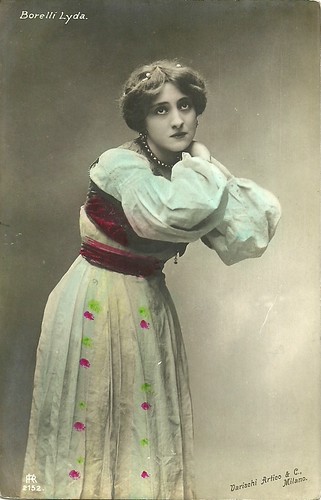
Italian postcard by Varischi Artico Co., Milano, no. 152. Lyda Borelli as Favetta in the stage play La figlia di Jorio (Gabriele D'Annunzio, 1904). In 1903 Gabriele D'Annunzio wrote the drama 'La figlia di Jorio' (The Daughter of Jorio), a pastoral tragedy situated in the Abruzzi mountains in center Italy. On 2 March 1904 the stage company Talli-Calabresi-Grammatica performed the premiere of the play at the Teatro Lirico in Milan. Protagonist should have been Eleonora Duse, but she fell ill. D'Annunzio, whose relationship with Duse was fading, didn't wait for her healing and gave the female lead to Irma Grammatica - which hurt Duse dearly. The painter Francesco Paolo Michetti, a good friend of D'Annunzio, designed the sets and costumes. The play was a huge success, also in Chieti in Abruzzi when it was performed there the same year. In 1907, with D'Annunzio's permission, a version in Abruzzese dialect was written and performed.

Italian postcard by RA, no. 3515. Photo: Varischi Artico & Co., Milano. Giannina Chiantoni as Ornella in 'La figlia di Jorio' (1904).
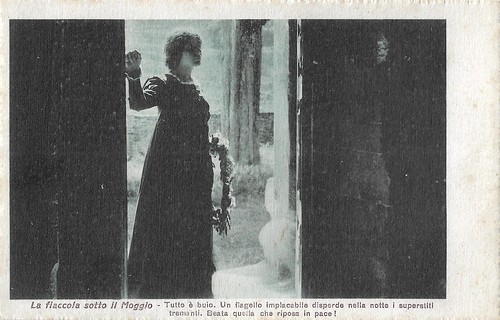
Italian postcard. Anna De Marco as Gigliola in La fiaccola sotto il moggio (Eleuterio Rodolfi, Ambrosio 1916), an adaptation of the play by Gabriele D'Annunzio. Caption: "All was dark. An unrelenting scourge scatters in the night the trembling survivors. Blessed is the one who rests in peace!" The vengeful Gigliola visits the grave of her mother in the family chapel, one year after the murder. She holds a wrath in her hands.
An announcement of fascist violence
During the First World War, Gabriele D'Annunzio advocated Italian participation in the conflict. In 1915, he enlisted in the Italian army. He became a fighter pilot. In 1917, he took part in the battles near the Isonzo river. On 10 February 1918, he took part in the raid on the Austro-Hungarian fleet in the port of Buccari. This raid was materially unsuccessful but had an important psychological effect. He received several military medals of honour.
Since Italy only acquired part of Dalmatia at the Treaty of Saint-Germain, but most of it was awarded to Yugoslavia, Gabriele d'Annunzio and his irregular troops (4,000 legionaries) occupied the city of Fiume (now Rijeka) on the Dalmatian coast on 12 September 1919 and founded the Italian Regency Carnaro. He thus became the figurehead of the irredentist movement in Italy. He declared that the Italian Regency of Carnaro was an independent state. He did not recognise the Treaty of Rapallo and declared war on Italy.
The regime installed by D'Annunzio in Fiume was a forerunner and had all the characteristics of the later fascist administration. This action was an announcement of fascist violence in the coming decades (compare D'Annunzio's 1919 speech to his troops (the Arditi): "every bullet from our guns must kill a Slovene or a Croat"). The 15-month occupation of Fiume ended when the Italian Navy bombed the city. D'Annunzio was wounded. This occupation showed the weakness of the Italian state.
At the end of 1920, D'Annunzio took possession of a confiscated villa on Lake Garda, where he lived until his death in 1938. In 1921 he became a member of the Académie royale de langue et de littérature françaises de Belgique. On the night of 13 to 14 August 1922, he fell out of a window of the villa where he lived. Possibly this was an accident, possibly he was pushed out of the window. Shortly afterwards, Benito Mussolini seized power. D'Annunzio kept silent about the exact circumstances of his fall. Mussolini had the writer guarded in the villa by some carabinieri. He feared the possible influence of D'Annunzio on public opinion or on the army.
In 1924, D'Annunzio was eulogised and given the title Prince of Montenevoso. In 1937, he warned Mussolini not to enter into a military alliance with Nazi Germany. A year later, in 1938, Gabriele d'Annunzio passed away in Gardone Riviera.
His literary style developed and changed regularly, but the development towards a kind of hedonism as it emerged at the beginning of the 20th century remains more or less central. His earlier work is lyrical, somewhat inhibited about the expression of emotions, in which naturalism can be recognised. D'Annunzio was associated with the Decadent movement, which interacted with French Symbolism. After 1883, under the influence of Friedrich Nietzsche, the 'übermensch' motif became central to his work.
His last novel, 'Forse che si, forse che no', is set in Mantua, in the Gonzaga palace. The protagonist is a nobleman who has a passionate relationship with Isabella. Unlike the other D'Annunzian 'übermenschen', he has understood the changes in the modern world. Instead of escaping into a decadent life, he indulges in machines, cars, and airplanes. He also sympathises to some extent with the Futurist art movement.
The novels of d'Gabriele D'Annunzio influenced those of his compatriot Curzio Malaparte. The tendency to identify with nature that occurs in d'Annunzio's poetry was adopted by Salvatore Quasimodo. Besides his novels, novellas, and poetry, D'Annunzio also left behind political works and about 10,000 letters.

Italian postcard by IPA CT, no. 3662. Photo: Film della Società Ambrosio, Torino. Helena Makowska in La Gioconda (Eleuterio Rodolfi, 1917), based on Gabriele D'Annunzio's play. Caption: The monk of the convent of St. Mark told the story of the golden scarabee.' Helena Makowska played the model Gioconda Dianti but also the Egyptian courtesan in the legend told. Left in the image Umberto Mozzato as the artist Lucio Settala.

Italian postcard by IPA CT, no. 3873. Photo: Film della Società Ambrosio, Torino. Helena Makowska in La Gioconda (Eleuterio Rodolfi, 1917), based on Gabriele D'Annunzio's play. Caption: The resurrected mummy told the monk, refugee in the desert, the story of her ancient life: She had been a voluptuous courtesan who lived in the times of the great Pharaon.'

Italian postcard by G.B. Falci, Milano, unnumbered. Photo: Unione Cinematografica Italiana. Maria Carmi as Isabella Inghirami in the Italian silent film Forse che sí, forse che no (Gaston Ravel, 1920), based on Gabriele D'Annunzio's eponymous novel (1910). The maddened Isabella does not understand Paolo's pleas anymore.

Italian postcard. G.B. Falci, Milano, unnumbered. Maria Carmi as Isabella Inghirami in the Italian silent film Forse che sí, forse che no (Gaston Ravel, 1920), based on Gabriele D'Annunzio's eponymous novel (1910). In 1916 the play had already been adapted to film by Mario Gargiulo, with Tina Xeo in the lead.
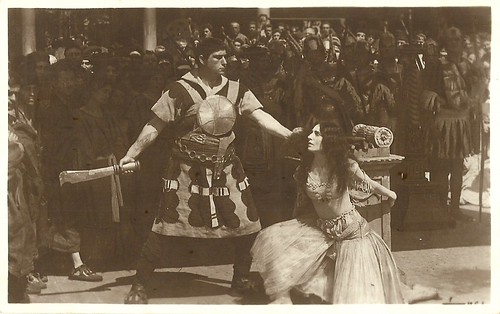
Italian postcard. Photo: Unione Cinematografica Italiana / Ambrosio-Zanotta. Ida Rubinstein in the Italian silent film La nave (Gabriellino D'Annunzio, Mario Roncoroni, 1921), based on the homonymous play by Gabriele D'Annunzio. In 1921, Russian dancer and actress Ida Rubinstein, close friend of Gabriele D'Annunzio, played the lead of Basiliola in the film La nave, directed by D'Annunzio's son Gabriellino and by Mario Roncoroni. The film was based on a play by D'Annunzio, which already had been turned into an opera and had been filmed in 1912 by the company Ambrosio, but without much success. Guido Marussig, who had designed both the play and the opera, designed sets, and costumes for the 1921 film. The directors shot the film in a style typical of the later silent epics in Italy, denying innovation in film language and instead focusing on acting, set & costume design, harking back to earlier epics such as Cabiria, but adding cruelty and sado-masochism. La nave is set in early medieval times. In the Venetian plains, at the town of Aquileia, Basiliola, daughter of the dethroned tribune Orso Faledro returns per ship and notices her father and brothers have been blinded by the Graticò brothers, of whom Marco (Alfredo Boccolini) is the new tribune and Sergio (Ciro Galvani) has become a bishop. Basiliola decides to ruin all involved. In an extended dance scene, she seduces Sergio, the lecherous bishop.

Italian postcard by Ed. Gel, series Aldo Fabrizi. Poster/lobby card for Il delitto di Giovanni Episcopo/Flesh Will Surrender (Alberto Lattuada, 1947), with Aldo Fabrizi and based on the novel by D'Annunzio.

Italian press photo. Photo: Mario Tursi. Giancarlo Giannini and Luchino Visconti discussing the text during the shooting of L'innocente/ The Innocent (Luchino Visconti, 1976). Setting: Tuscany, near Lucca. Collection: Ivo Blom.
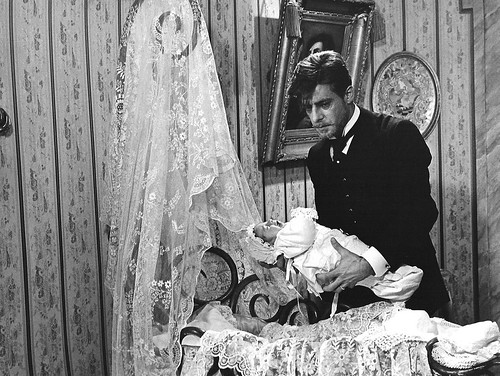
Italian press photo. Photo: Mario Tursi. Giancarlo Giannini in L'Innocente/The Innocent (Luchino Visconti, 1976). Collection: Ivo Blom.
Sources: Wikipedia (Dutch, French, and English), and IMDb.
No comments:
Post a Comment